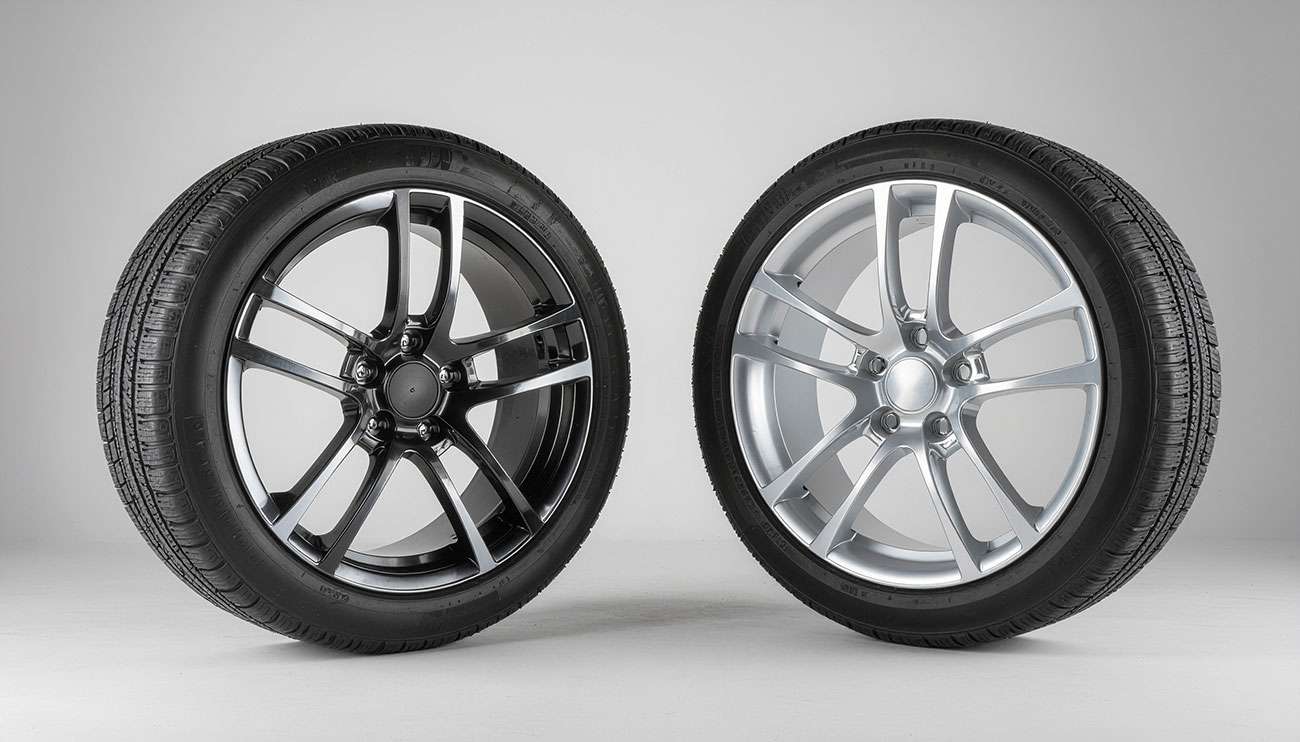
Incorrect wheel offset can turn a simple wheel upgrade into a costly mistake that impacts everything from handling to safety. Many vehicle owners focus on how their new wheels look, but the offset you choose affects far more than appearance. The problems with wrong wheel offset are serious and wide-ranging, affecting your vehicle's performance, tire life, and safety on the road.
Wheel offset—the distance between the hub mounting surface and the wheel's centerline—plays a critical role in how your vehicle handles. When this measurement is wrong, the results can be dangerous. An offset that's too positive or negative causes tires to rub against fenders or suspension parts, creating premature tire wear and potential damage. Wrong offset also creates uneven tire wear patterns, especially on the inner or outer edges. This misalignment affects more than just looks—it can alter suspension geometry and cause alignment problems over time.
At Performance Plus Tire, we understand that proper wheel fitment goes beyond style. The right offset ensures your wheels work as designed with your vehicle's suspension system, maintaining the performance and safety you expect from your ride.
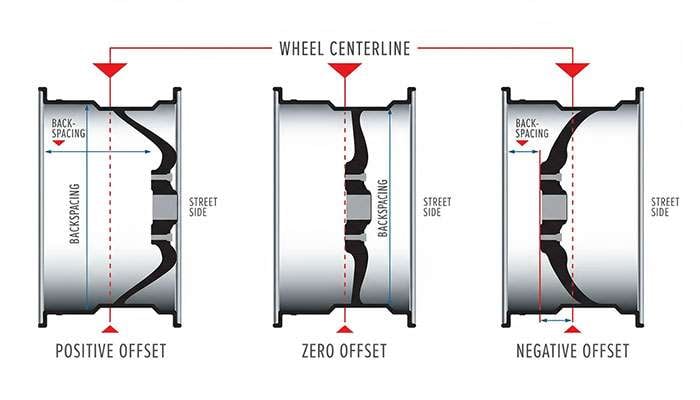
Understanding wheel offset is essential before exploring the problems it can cause. Wheel offset represents the distance from the hub mounting surface (where the wheel attaches to the vehicle) to the centerline of the wheel. This measurement determines how your wheels sit relative to the suspension and body of your vehicle.
Wheel offset defines how your wheels are positioned within the wheel wells. Picture a straight line cutting through the middle of your wheel when viewed from the side—this is your centerline. The offset is how far the mounting surface sits from this imaginary line. This positioning affects handling characteristics and your vehicle's overall appearance.
Wheel offset is measured in millimeters for precise fitment. To calculate offset yourself, you need three measurements:
The wheel's width
The backspacing (distance from the inside edge to the mounting surface)
The wheel centerline (half the wheel's width)
Subtract the wheel centerline from the backspacing to determine the offset. If backspacing is greater than the centerline, you have positive offset. If it's less, you have negative offset. Convert inches to millimeters by multiplying by 25.4.
Wheel offset comes in three types:
Zero offset occurs when the mounting surface aligns perfectly with the wheel's centerline. This creates a balanced position with no inward or outward bias.
Positive offset means the mounting surface is located in the front half of the wheel, closer to the street side. This tucks the wheel inward toward the suspension and brakes. Most modern vehicles, especially front-wheel drive and newer rear-wheel drive cars, use positive offset wheels from the factory.
Negative offset positions the mounting surface in the back half of the wheel. This pushes the wheel outward, creating a wider stance and the "deep dish" appearance popular on customized vehicles and off-road trucks.
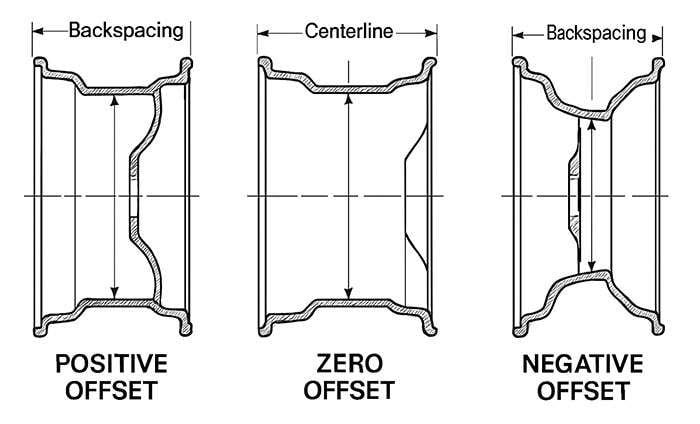
Changing wheel offset directly affects your vehicle's handling in ways most owners don't expect. The relationship between your wheels and steering system becomes altered, creating several serious problems that can impact your driving safety.
Scrub radius is the distance between your tire's centerline and the steering axis where they meet the ground. When you change wheel offset, you alter this critical measurement. A wheel with more negative offset moves everything away from your steering axis, creating a higher scrub radius. This forces your tire to swing in an arc rather than pivot cleanly when turning, making steering much harder.
Higher positive scrub radius makes your steering more sensitive to forces from acceleration and braking. During braking, positive scrub creates a toe-out effect that makes your vehicle less stable and prone to darting in different directions. You'll notice heavier steering and more feedback from bumps—and not the good kind. The greater the scrub radius, the more effort required to steer and the more unwanted feedback you'll feel.
Wrong offset creates serious problems on rough surfaces. When you shift the fulcrum of your contact point with the ground away from your suspension's designed geometry, you put more strain on components. Hitting potholes or bumps with excessive positive scrub radius can jerk the wheel from your hands as forces pull unevenly on your steering.
Think about what happens during a tire blowout—with excessive scrub radius, the steering pulls dramatically to one side, creating a dangerous situation. Even normal road imperfections can cause your vehicle to wander unpredictably when offset is wrong.
Vehicles with incorrect offset face serious performance issues, especially during high-speed cornering. While wider track width from lower offset might seem to improve stability, the handling benefits often come with dangerous drawbacks.
High-speed maneuvers become more dangerous as the vehicle's center of gravity shifts, affecting weight distribution through corners. The scrub radius changes make steering less predictable during aggressive cornering, when you need precision most. Your vehicle might understeer or oversteer differently than expected, creating dangerous situations on highways or in emergency lane changes.

Wrong wheel offset doesn't just affect handling—it also creates excessive wear on critical suspension and steering components. These mechanical problems can lead to expensive repairs and safety issues over time.
Wheel bearings support your vehicle's weight and handle lateral forces during turns. When offset is wrong, the load on these bearings increases significantly. More negative offset creates a longer lever arm from the bearing to the tire's contact patch, multiplying the forces on the bearing during cornering and daily driving.
This extra stress causes bearings to wear faster than normal. You might hear grinding noises, feel play in the wheel, or notice uneven tire wear as bearings fail. Replacing wheel bearings is expensive, and driving on failing bearings is dangerous.
Your suspension components are engineered for specific loads based on factory wheel dimensions. Changing offset alters these loads. Control arm bushings and ball joints face increased stress from the changed geometry, leading to premature wear and failure.
Control arms connect your wheels to the chassis and maintain alignment during suspension travel. When offset changes create different angles and loads, bushings deteriorate faster. Ball joints that allow steering motion while supporting the vehicle's weight also wear out prematurely under incorrect loading conditions.
The steering rack and tie rods connect your steering wheel to the wheels. Wrong offset increases the mechanical advantage needed to turn the wheels, putting more strain on these components. Tie rod ends, which allow the wheels to steer while moving up and down with the suspension, face accelerated wear from increased scrub radius.
Over time, this extra stress can cause steering looseness, vibration, and eventual component failure. You might notice more play in the steering wheel or hear clunking sounds when turning.
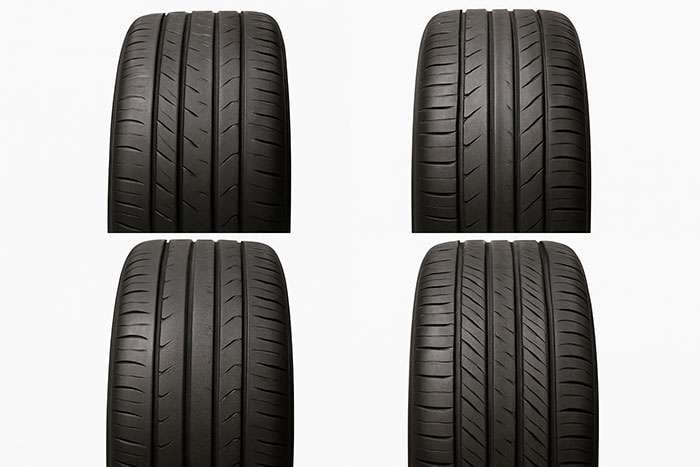
Incorrect wheel offset creates distinctive tire wear patterns that signal problems with your vehicle's setup. These patterns not only reduce tire life but also indicate potential safety issues.
When wheel offset changes, it often affects camber—the angle of your wheels relative to the road surface. Excessive positive offset can push the top of the tire inward (negative camber), while too much negative offset might create positive camber. Either situation causes accelerated wear on one edge of the tire.
Inner edge wear is particularly common with offset that's too positive. The tire leans inward at the top, concentrating weight and friction on the inside edge. This wear pattern develops quickly and can destroy a tire in half its normal lifespan.
Improper offset can also contribute to center wear and feathering. While center wear typically comes from overinflation, the altered suspension geometry from wrong offset can affect how weight distributes across the tire's contact patch. Feathering—where tread ribs wear at different angles—often indicates toe alignment problems that wrong offset can cause or worsen.
These wear patterns create noise, reduce traction, and shorten tire life. Once feathering begins, the tire's performance degrades quickly.
Wrong offset can create uneven wear that doesn't fit standard patterns. You might see wear concentrated in certain areas or diagonal wear patterns. This happens because the tire's contact patch shifts as suspension geometry changes, creating inconsistent wear across different driving conditions.
Such uneven wear reduces grip, especially in wet conditions where worn areas can't channel water effectively. The tire becomes more susceptible to hydroplaning and loses traction during emergency maneuvers.
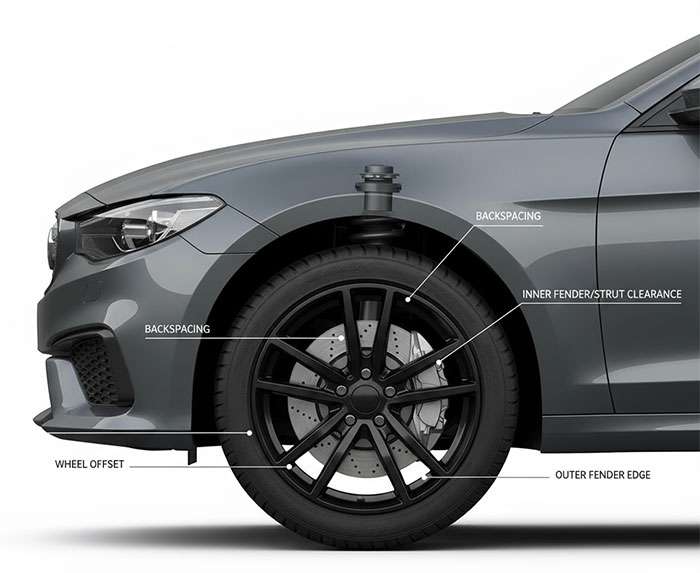
Beyond performance issues, incorrect wheel offset creates several practical problems that can affect your vehicle's safety and ownership experience.
Wheel offset directly affects brake caliper clearance—the space between your wheel and braking components. A wheel with too much positive offset might not have enough inner barrel clearance for brake calipers. Even wheels with the same diameter can't guarantee proper clearance, since spoke design and depth make a big difference in fitment. Without enough space, your wheel might scrape against brake parts or fail to mount completely, creating serious safety risks.
Wrong offset calculations often lead to tire-to-fender contact. If your offset is too low (more negative), tires might rub against the fenders, while too much positive offset risks contact with suspension parts or inner fender liners. This rubbing shows up most during hard turning, heavy braking, or when driving over bumps. Watch for signs like unusual tire wear patterns, burning rubber smells, or scraping noises.
Many regions have road safety rules against wheels that stick out beyond the vehicle's body. Protruding tires create hazards for pedestrians and can cause more severe injuries during accidents. Some areas may fail your vehicle inspection or issue traffic citations for this modification. These rules exist because exposed wheels throw water, grit, and debris onto other vehicles and pedestrians.
Aftermarket wheel modifications, including offset changes, may affect your vehicle's warranty coverage. If wheel modifications cause vehicle problems, manufacturers might deny warranty claims. The Magnuson-Moss Warranty Act requires automakers to prove that aftermarket modifications caused the specific failure. Wrong offset changes might also affect insurance coverage, especially if they contributed to an accident.
When selecting custom wheels, it's important to consider these factors alongside performance and appearance. Our experienced team can help you choose wheels that meet legal requirements while providing the style and performance you want.
Choosing the right wheel offset is one of the most important yet overlooked aspects of wheel selection. We've seen how wrong wheel offset creates problems that affect virtually every aspect of vehicle performance. Safety concerns come mainly from handling instability, especially during emergency situations when you need precise control most.
Vehicle owners need to understand that offset isn't just about looks. It changes suspension geometry, bearing loads, and steering characteristics. Negative offset wheels might give you an aggressive stance, but they also put extra stress on wheel bearings and suspension parts. Positive offset usually looks more conservative, but it can cause problems when it doesn't match your vehicle's specifications.
The cost of wrong offset goes far beyond what you pay for the wheels. Premature tire wear, bearing failure, and damaged suspension components add up to serious money over time. Warranty problems and insurance complications make proper offset selection even more critical.
Before buying new wheels, consult with qualified professionals or check manufacturer specifications carefully. Taking time to confirm proper offset measurements saves you money and problems later. Aftermarket wheels offer great customization options, but they require careful attention to these technical details.
At Performance Plus Tire, we have the expertise to help you select wheels with the correct offset for your vehicle. Our fitment specialists understand how offset affects performance and can guide you to the right choice for your specific needs.
Wheel offset balances appearance, performance, and safety. The position of your wheels affects everything from turning ability to highway stability. Making smart decisions about wheel offset protects your vehicle and keeps you safe on the road.
Understanding wheel offset is crucial for vehicle safety and performance, as incorrect measurements can lead to serious handling issues, premature component wear, and costly repairs.
• Incorrect offset compromises steering safety - Wrong offset increases scrub radius, causing heavy steering, kickback on bumps, and dangerous instability during emergency maneuvers.
• Premature wear accelerates repair costs - Improper offset creates uneven tire wear patterns and multiplies stress on wheel bearings, suspension arms, and steering components.
• Fitment issues create legal and safety risks - Wrong offset can cause brake clearance problems, fender rubbing, and tire protrusion that violates road safety regulations.
• Professional consultation prevents expensive mistakes - Consulting qualified professionals or researching manufacturer specifications before wheel purchase saves money and ensures proper vehicle performance.
• Small offset changes have major consequences - Even 5-10mm differences in offset can dramatically affect high-speed stability, component longevity, and overall vehicle safety.
Remember that wheel offset isn't just about appearance—it's a critical safety specification that affects every aspect of your vehicle's performance, from daily driving comfort to emergency handling capabilities.
Incorrect wheel offset can significantly impact vehicle handling. It may cause increased steering effort, reduced stability during cornering, and unpredictable behavior on uneven terrain. The changes in scrub radius can lead to steering kickback and compromised control, especially during emergency maneuvers or at high speeds.
Improper wheel offset often results in uneven tire wear patterns. You may notice accelerated wear on the inner or outer edges of the tires. This uneven wear not only shortens tire lifespan but can also indicate potential stress on suspension components and wheel bearings.
Yes, incorrect wheel offset modifications can potentially void parts of your vehicle's warranty. Manufacturers may deny warranty claims if they can prove that aftermarket wheel modifications caused a specific failure. It's crucial to consult your warranty terms and consider professional advice before making significant changes to your wheel setup.
There can be legal implications when changing wheel offset. In many regions, wheels that protrude beyond the vehicle's body are against road safety regulations. This can result in failed vehicle inspections or traffic citations. Additionally, protruding wheels pose increased risks to pedestrians and other road users.
Generally, it's recommended to stay within 5 millimeters of the original wheel offset. Even small changes of 5-10mm can affect vehicle stability, especially at high speeds. Larger deviations can lead to significant handling issues, accelerated wear on components, and potential safety risks. Always consult with a professional or refer to manufacturer specifications when considering wheel offset changes.